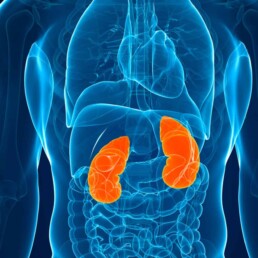Kidney stone formation is a complex disorder influenced by multiple factors including diet, genetics, and environment, as reviewed in our earlier blogs. Kidney stones are painful, inconvenient, and when left untreated, they may contribute to more serious conditions including obstruction and kidney damage. The gut also plays an important role in kidney health and is described as the “gut-kidney connection.” In this blog, we will discuss the mechanisms and genetics behind electrolyte balance in the gut and kidneys, which can influence the treatment of kidney stones.
The gut-kidney connection refers to how a healthy gut barrier and diverse microbiome (the collection of friendly bacteria living in our intestines) directly influences kidney health. The connection between the gut and kidneys is very complex but we break it down into two major categories as we discussed in previous blogs: the gut-derived uremic toxins, and the inflammatory immune response that can trigger kidney disease.
In addition, as the gut is the gateway of nutrients into the body, it plays a major role in the balance of water and electrolytes such as sodium, potassium, magnesium and calcium.
The role of the gut in water and electrolyte balance
All of our water requirements are met by consuming food and beverages which are absorbed in the gut. In fact, water absorption in the gut is so powerful that, out of the 6 L of gastrointestinal secretions and 2 L of oral intake every day, only 150 ml are lost in the stool. Water absorption in the gut also depends on absorption of carbohydrates in the small intestine and short chain fatty acids (derived from the microbiome) in the large intestine.
Both the gut and the kidneys influence the body’s electrolyte balance. In most instances, electrolyte transport in the gut utilizes similar transporters to those found in the kidney tubules. Electrolytes are also regulated by hormones and neurotransmitters. These include neurotransmitters of the sympathetic system, compounds such as prostaglandins and hormones such as aldosterone.
Prostaglandins, for example, stimulate active electrolyte secretion in the small intestine and colon. Prostaglandins can also affect electrolyte handling by the kidneys. Aldosterone is well known to affect sodium, potassium and magnesium balance in the body by its effects on the kidneys and the colon.
The gut can also excrete water to help balance electrolytes in the body. Indeed, the gut is so effective in ridding the body of unwanted electrolytes that it can improve potassium balance in advanced stages of kidney disease.
The gut-kidney connection in electrolyte balance
Recently, a small protein called uroguanylin was discovered. It was found to regulate the transport of sodium in the gut and kidney and electrolyte balance by activating cGMP. Uroguanylin is often described as the “gut monitor of sodium intake.”
Most of what we know about uroguanylin so far comes from rat studies. For example, rats on low salt diets showed increased production of uroguanylin. If salt was given orally, there was a rapid increase in urinary salt excretion. However, if salt was given through the veins, urinary salt excretion was delayed. Similar findings were seen in humans but uroguanylin levels were not measured.
Other studies showed that giving intravenous uroguanylin can increase water, sodium and potassium excretion in the urine. These studies indicate that uroguanylin acts as a mediator of the gut-kidney axis because it regulates water and electrolyte balance.
The role of the gut in calcium balance
The gut also plays an important role in calcium balance. The strict balance of calcium in the blood is crucial for many biological functions. An interaction between the gut, the kidneys, and the bones helps maintain tight control over calcium levels.
Calcium is absorbed in the gut by two general mechanisms: transcellular active transport process and a passive paracellular (in between the cells) process.
Active transport mainly occurs in the first part of the gut (duodenum and upper jejunum). It plays an important role in absorbing calcium when calcium intake is too low. In active transport, calcium enters the cells of the gut through calcium-selective ion channels (CaT1). Calcium is then transported within the cell by calcium-binding protein (CaBP) and it is deposited into the bloodstream by a calcium ATPase pump (CaATPase).
Passive transport occurs throughout the gut. It is most important when calcium intake is high. Paracellular transport of calcium depends on the difference in electricity and concentration across the cells in the gut lining. It involves specialized proteins called claudins.
The table describes key differences between the two mechanisms of calcium absorption in the gut.
| Calcium Absorption in the Gut | ||
| Transcellular | Paracellular | |
| Energy required | Active | Passive |
| Location | Upper small intestine | Throughout the intestine |
| Transporters involved | CaT1, CaBP, CaATPase | Claudins |
| Baseline dietary status | Low calcium intake | High calcium intake |
Like the gut, the kidneys are responsible for maintaining calcium balance. The kidney tubules recycle needed calcium and add it back to the blood, a process called reabsorption. Unlike calcium transport in the gut, most calcium reabsorption in the kidneys occurs via a passive paracellular transport in the proximal tubules. When the kidneys filter excess calcium out of the blood, calcium is excreted in the urine through active transcellular transport in the distal tubules. Active transport utilizes calcium channels while passive transport also utilizes claudins.
Claudins
Claudins are a family of proteins that participate in forming strong and healthy barriers between cells that line the gut and the kidneys. These barriers are important to prevent “leaking” in between cells and to keep bad things out of the bloodstream. The space between two cells that fit closely together is called a tight junction. Claudin-2 is found in the tight junctions of the proximal tubule of the kidney and plays an important role in paracellular calcium reabsorption. What is fascinating is that claudin-2 was also found to be part of the tight junctions in the gut. Studies have demonstrated that claudin-2 is a mediator of intestinal permeability during intestinal inflammation. Read more about intestinal permeability here.
Genetic variation in claudin-2
Genetic variations in the gene that codes for claudin-2 (CLDN2) have been documented to decrease the paracellular “leak” of calcium. So genetic variations in the CLDN2 make the tight junctions tighter and the barrier stronger. This change decreases the ability of the kidneys to filter calcium and add it back to the blood. Since calcium cannot be properly recycled, it is excreted in the urine at high levels and increases the risk for kidney stones.
Interestingly, the increase in calcium in the urine is not accompanied by an increase in blood calcium, parathyroid hormone, or 1,25 dihydroxy vitamin D3 levels. This indicates that there is an accompanied increase in absorption of calcium in the gut. This will help maintain calcium balance in the blood which is crucial for many biological functions.
In essence, the same genetic variations in CLDN2 that lead to increased calcium in the urine also lead to an increase in calcium absorption in the gut. This effectively maintains calcium balance in the blood but increases the risk for kidney stones. This was proven in a study showing that low calcium in the diet leads to low calcium in the urine of people with the CLDN2 genetic variation.
The bottom line
There is also a gut-kidney connection when it comes to electrolyte balances in the blood. Understanding the mechanism and the genetic basis of electrolyte disorders may help individualize treatment for kidney patients. Kidney stone patients with CLDN2 genetic variants, for example, may benefit from dietary calcium restrictions which is generally not recommended for all kidney stone patients. We utilize Natera’s Renasight broad panel genetic test to identify the genetic risk for kidney stones. For more information, check out our blog about the integrative approach to kidney stones.






